Prior to travelling to Japan, I was under the impression it was an extraordinarily expensive destination. Whenever I would ask anyone about their trip to Japan I would get the usual reply “It was great, but very expensive.” I heard this reply so much I started to view Japan as an unreachable place, a luxury destination that would require a lot of saving and budgeting. I didn’t know just how much I could save money in Japan.
For the most part, Japan isn’t that expensive. Many attractions and temples are completely free to enter, local restaurants are reasonable and there are many transportation options to suit all budgets.
I am sharing some money-saving tips I picked up, so you can experience Japan no matter what your budget. I hope this post will make you realise you don’t need a ton of savings to see this incredible country.
Is Japan Expensive?
I was pleasantly surprised by Japan’s affordability, many sights are free to enter, restaurants are reasonably priced, groceries are inexpensive and transport is good too. However, if you are on a budget or off the back of travels across Southeast Asia, Japan might feel expensive.
Accommodation is by far the biggest expense, rooms/ apartments are tiny with a big price tag.
23 Ways To Save Money In Japan
Food Saving Tips
1. Conbinis
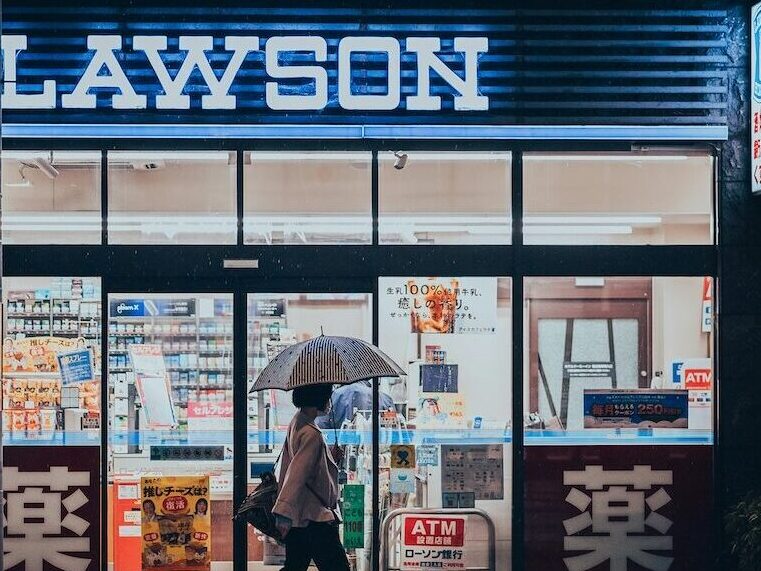
Conbinis are convenience stores such as 7-11, Family Mart and Lawson. They may be small in size but mighty in what they offer.
Forget what you know about convenience stores back home. In Japan convenience stores stock fresh gourmet meals, snacks and desserts that could rival many restaurants. Food standards in Japan are extremely high, the meals are clean, flavourful and usually well-balanced. They are an affordable option for anyone on a budget. When at the check out the staff member will ask if you would like the food heated in store. You can then use the in-store seating area to consume the food.


You can get a range of different meals from ramen, curry, pasta, fish, and sushi to salads, onigiris and soup. I personally loved Onigiri’s for a quick breakfast on the go, they were just ¥150.
Most of the larger meals will cost under ¥1,000, this will be good news for anyone looking to save money in Japan.
2. Grocery Golden Hours


At about 8 pm every night you see people lurking in the shadows of the fresh ready meal aisles waiting, eyeing up the containers for the coveted yellow discount sticker. A member of staff will diligently (and sometimes painstakingly slowly) place a yellow sticker with a discount of up to 60% off of the day’s leftover foods.
The food in grocery stores is another level up from the fresh food in Conbini stores. Often prepared in the grocery store’s kitchen you will find large platters of sushi, katsudon, delicious sandwiches, bento boxes and so much more.
Some grocery store brands to look out for in Japan are Life, Tomibun, Ikari and Tamade.
3. Strawberries
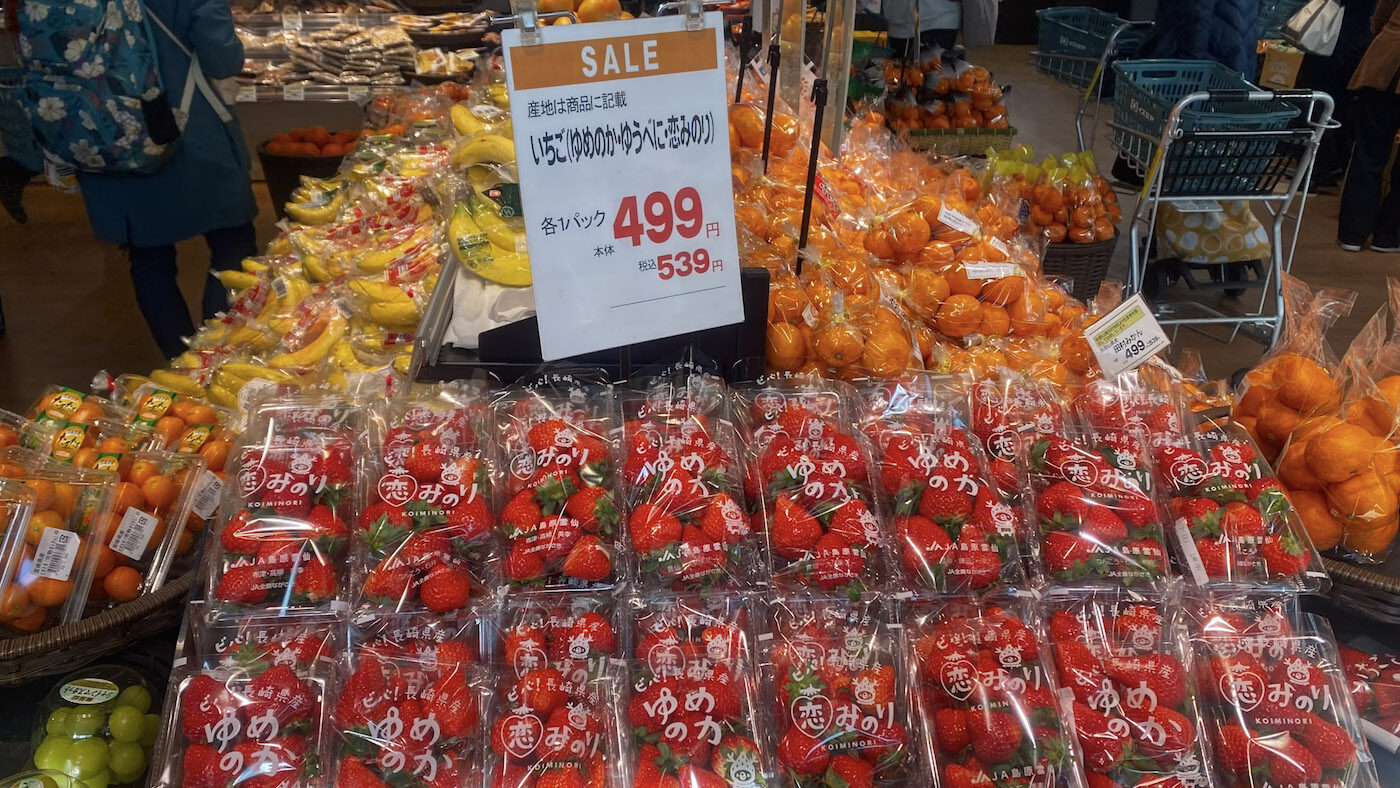
Japan is famous for its juicy and sweet strawberries, they are so delicious but can be eye-wateringly expensive. You will likely become tempted to buy a basket while strolling through a food market or vendors on the street (close to the tourist attractions). The good news is that you can get the same strawberries, maybe even fresher from a grocery store for a more budget friendly price.
You might also like: Osaka Digital Nomad Guide
4. Conveyor Belt Sushi


Sushi is Japan’s most famous dish, fresh, tasty and let’s be real for some it is an adventurous culinary experience. I think it is a must-do activity for anyone visiting Japan.
The prices for sushi restaurants widely vary, some high-end establishments charge over ¥150,000 for a meal, yikes! Thankfully, this pendulum swings the other way.
Kaiten-sushi is conveyor belt sushi, a fast, fun and deliciously affordable way to experience sushi in Japan. Because it’s Japan this will not be like the conveyor sushi restaurants you tried at home, this is truly high quality. You sit at a counter, plates of covered sushi will pass by on a track and you take whatever you want.
Prices start at ¥100 per plate and go up to about ¥1,000 for the higher-end options. At the end of your meal, your plates will be counted and you’ll get the bill.
Not only is this an excellent option for anyone looking to save some cash but it is a fantastic place to learn a bit about sushi, what you like and what you don’t. You can then feel confident to move on to the more expensive places.
Daiki-suisan is a reliable Kaiten-zushi chain that can be found across Japan.
5. Standing Ramen Bars


Ramen in Japan is generally affordable at approximately ¥900 per bowl, especially if you stick to the back alleys and avoid the well-known brands.
An even cheaper alternative to regular ramen joints is Tachigui, also called standing ramen bar. As the name suggests you will be standing at a counter eating your bowl of ramen with no seat. This style of restaurant has a fast turnover of customers allowing prices to be low, expect a bowl of ramen to cost about ¥400 here.
6. Beer is expensive


This next one is small, but if you like beer it could result in big savings.
Japan has a high import tax on beer, so expect to pay around 600 – 1000 yen for a beer in a bar, the price will be higher for a craft beer. However, the beers in Konbinis are much cheaper costing about 250 yen for a can. It is worth noting you can find cheaper beer in a torizoku instead of a bar.
The cheapest and in my opinion the best drink to get in a bar is a highball. Made of whiskey, gin or vodka mixed with ginger ale, or soda water served with ice. They are very refreshing and cost around 500 yen. Popular highball brands that you can purchase in konbinis are Asahi and Strong Zero.
7. Water
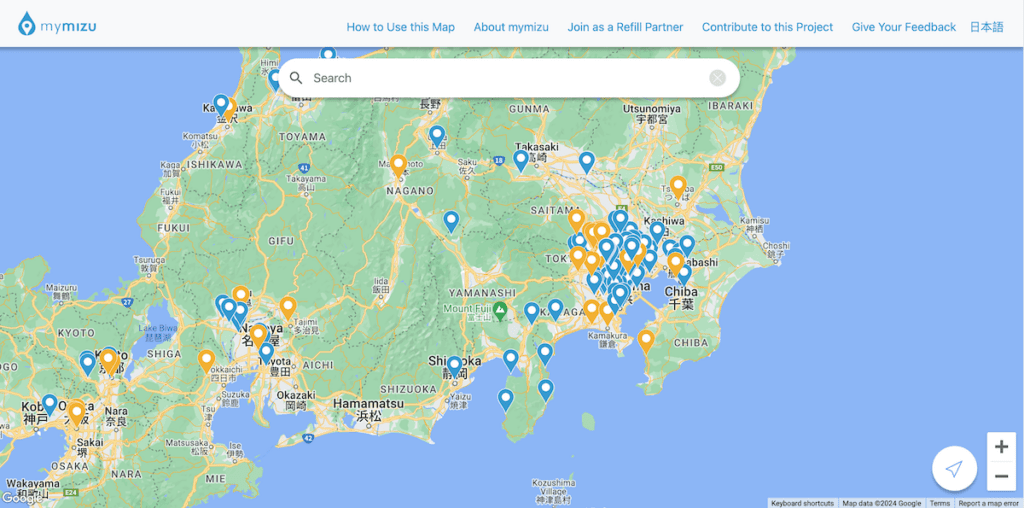
Trust me, you will be doing a lot of walking during your trip to Japan, all those steps will require plenty of water. Although you can easily find vending machines and conbini’s everywhere in Japan, a more cost-effective and environmentally friendly option is to carry a reusable water bottle with you.
Mymizu is a free app that will show you where all the water stations are in Japan. This handy app will help you save money in Japan.
8. Dont Eat Too Close To The Tourist Hotspots
It is definitely easier to go to the restaurants closest to the big attractions, the menus are usually in English, the staff tend to speak English and it just seems so welcoming. Usually the food isn’t the most authentic as it is amended to suit Western tastebuds and the prices are significantly higher.
If you just spend 5 minutes walking a street or two away, I guarantee you will find meals for half the price and triple the flavour.
Transport Tips


9. Forget about Taxi’s
Taxis in Japan are not only super expensive but totally unnecessary. As an example, a 1-hour taxi from Tokyo’s Narita airport to Shibuya costs ¥31,000. The airport train starts at ¥2,300 with the same journey time.
10. JR Pass Calculator
If your length of stay in Japan is between 7-12 days and you plan to move to a number of different locations in Japan, you should purchase a JR Pass.
A JR Pass can result in significant savings but you need to do the maths first. This JR Pass calculator will outline if the pass is worth it for your trip.
You can purchase the JR Pass here.
11. Seishun 18 Ticket
Seishun 18 Kippu is a seasoned railway ticket with 5 non-consecutive days of unlimited travel on local and JR trains. It is open to residents and foreign tourists.
The catch is that you can only use it during the school holidays and it can only be purchased from JR stations, not online.
With a cost of ¥12,050 per ticket, it can work out to be an excellent way to save money in Japan.
12. Consider Bus Travel
We all hear about how amazing the Shinkansen (bullet trains) are in Japan, it is true they are comfortable, extremely fast and efficient but they are very expensive. I don’t hear many people talk about bus travel in Japan, but it exists and can result in outstanding savings.
Japan also has night bus routes, buses are comfortable, and most will have a privacy curtain. Taking a night bus will result in a saving on one night’s accommodation.
Here are a few websites you can use to book buses in Japan:
13. Fly Domestically
Maybe the Shinkansens are too expensive and the buses are too time-consuming, how about flying? Japan has brilliant budget airlines such as Peach, Jetstar and Starflyer which can fly you to your destination in half the time and are usually cheaper than the bullet trains.
Sites like Skyscanner are an excellent tool when comparing prices.
14. Not All Airports Are Equal
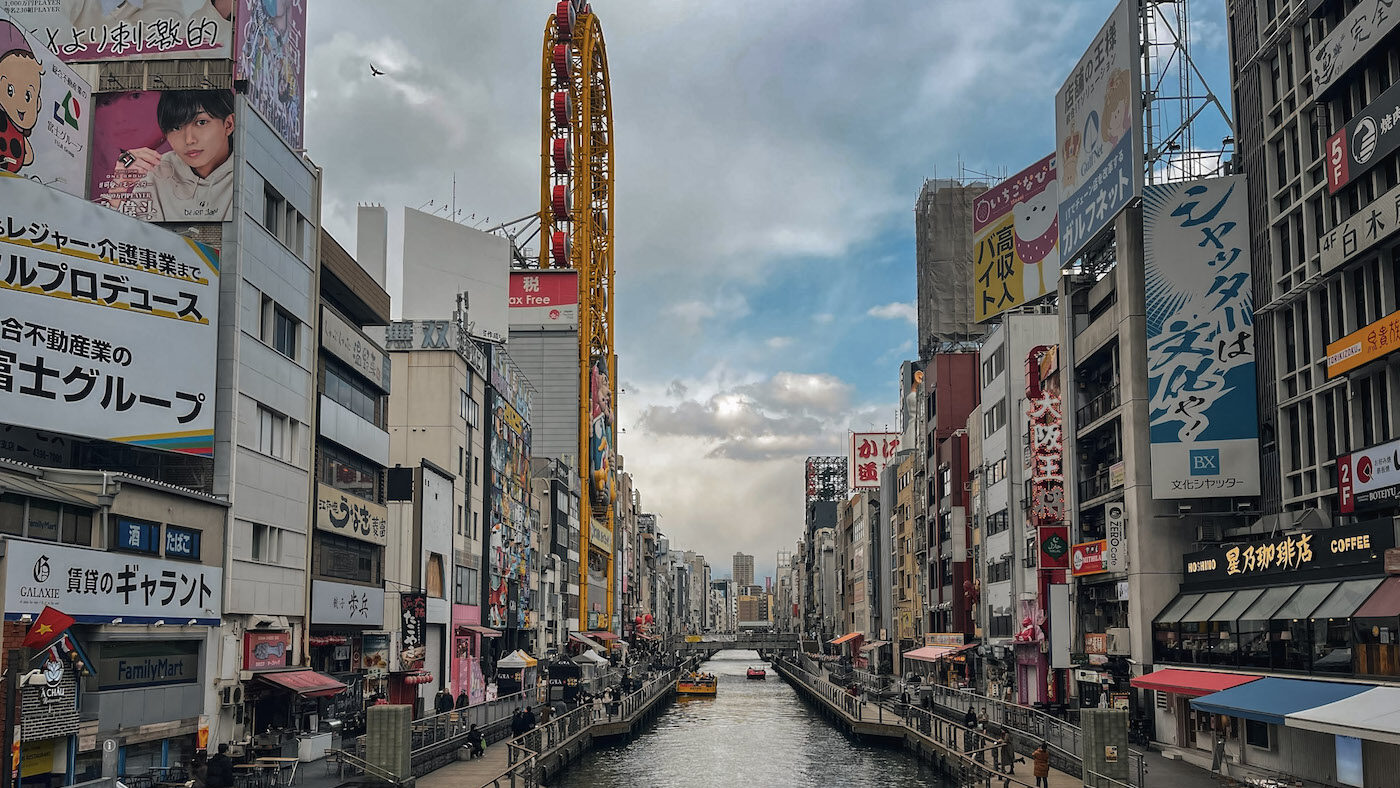
The most popular and expensive airport to fly into in Japan is Tokyo’s Narita, Osaka (NIX) is the cheapest. It is worth checking a variation of flight options on Skyscanner, you could end up saving a couple of hundred.
15. ICOCA, SUICA OR PASSMO Card
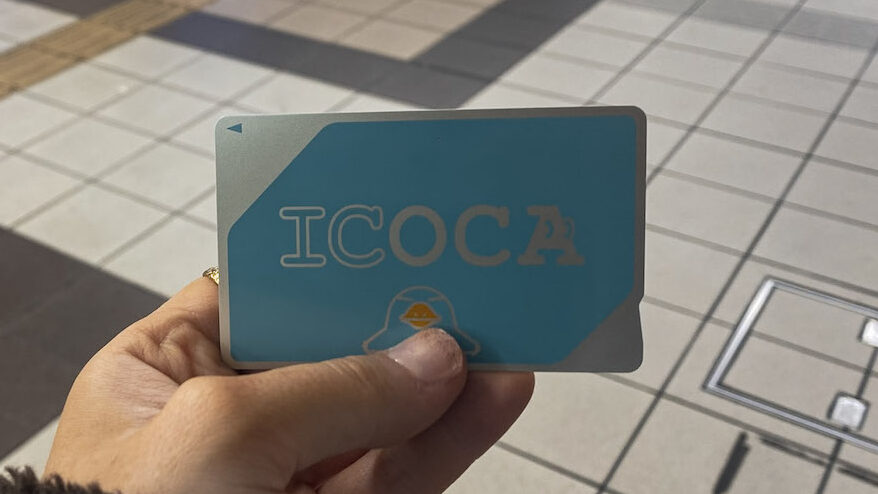
ICOCA, PASSMO and SUICA are rechargeable transport cards that you load with money and use on public transport by tagging on and off. The cards are available in physical or virtual form, however the physical cards can often have a shortage.
To use the virtual card you can just search for the card in Apple Wallet, and then top it up from there. You then tap on and off by holding your phone to the machines.
16. Day Trips


Choosing a base to stay at and taking day trips can be a much more cost-effective plan than changing accommodation every 2 – 3 days.
For example, if you stay in Osaka you will have a larger selection of affordable accommodation than Kyoto or Nara. Both Kyoto and Nara are extremely popular locations with inflated hotel and restaurant prices. You can reach both cities by train in just 30 minutes from Osaka. You can also get to Kobe in 20 minutes from Osaka.
Additionally, many accommodation sites give weekly discounts to guests staying 7 nights.
Miscellaneous Tips
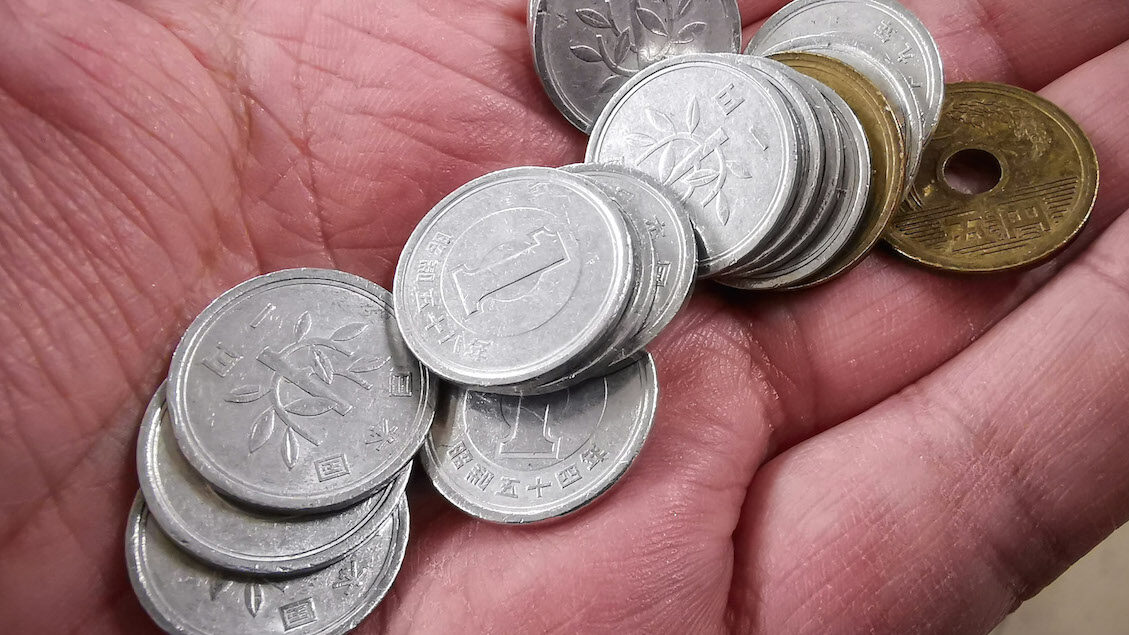
17. ¥100 Stores
¥100 stores, also called Japanese Hyaku-en are a haven for bargains. AirBNB has no cups? ¥100 store! Run out of make-up remover? ¥100 store! Want a cute souvenir or two? You guessed it ¥100 store.
These discount stores sell everything for ¥100, making it the perfect stop for travellers on a budget. You can find the stores all over Japan. They sell a wide range of products, from clothing, cosmetics and snacks to kitchenware, DIY tools and stationery.
Popular chains are Daiso, CanDo and Seria.
18. City Pass
Consider purchasing a city pass such as the 1 week Kansai Pass, Osaka Amazing Pass, Tokyo Pass, or Okinawa Fun Pass.
These passes can save you up to 5,900, but you will need to plan your itinerary and check if the pass covers most of what you plan to do. The passes also include unlimited subway rides.
19. 7-11 ATM
I found the best place to withdraw money was from the 7-11 ATMs, the fees are very low. In addition, they are everywhere and open 24 hours, making it a convenient option.
Always use your bank’s exchange rate, therefore in Japan choose to pay in yen, not your home currency.
20. Free Walking Tours
Although not entirely free they are based on tips, they are a fantastic budget activity that will leave you full of local knowledge. Here are some free walking tours in Tokyo, Kyoto, and Osaka.
21. Business Hotels
Accommodation is the most expensive part of travelling Japan, unless you book months in advance the choice is limited and usually the rooms are very small. Along with the usual hotels and Airbnb Japan has a few different choices when it comes to sleeping on a budget.
Business Hotels offer a no-frills experience. The concept of this type of hotel is that it is for guests visiting for the purpose of business, not leisure or relaxation. Therefore it only has the basic necessities, there won’t be a pool or spa here. The rooms are small but also clean and comfortable.
Popular business hotel chains are APA, Daiwa Roynet Hotel and Dormy Inn.
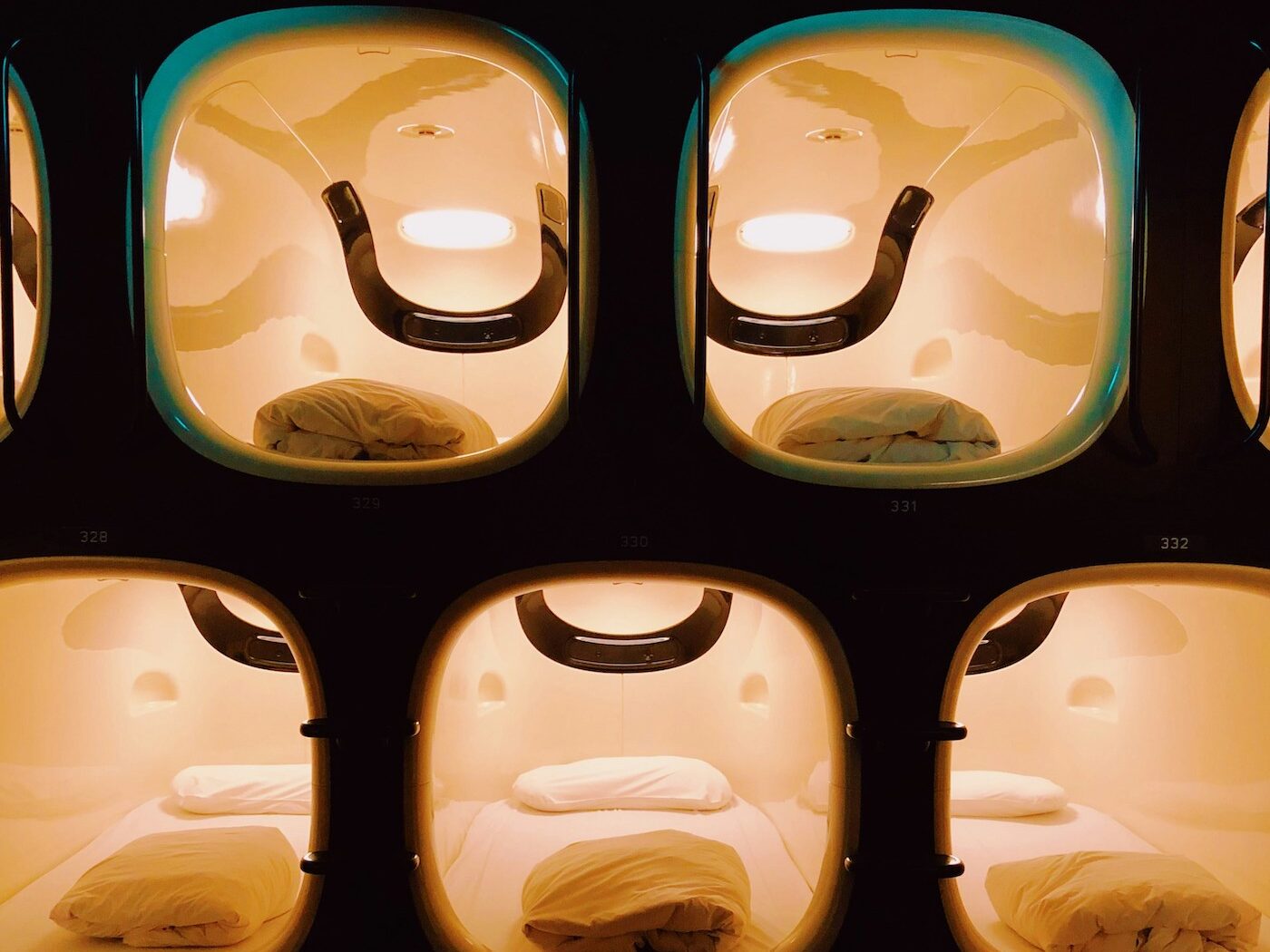
Capsule Hotels are guaranteed to be one of the most unique sleeping experiences you will have. They look super futuristic, small pods stacked on top of one another with just a bed and sometimes a TV inside. Floors are male or female only, genders will not mix. Luggage is stored in another area and bathrooms are at the end of the hall.
Reliable capsule hotel chains are 9h, Book and Bed, First Cabin, and Bay.
Other accommodation offerings are Minshuku (family-run guest house) and Ryokans (Japanese inns), both are very similar and serve meals.
22. Off Season
A tale as old as time, but don’t think Japan is only good during the highly praised seasons of spring and autumn. Consider travelling during the off-season, summer and winter to save money in Japan.
Summer and winter have negative qualities such as summer being very humid, which makes it hard to explore all day but there are some awesome festivals. Whereas winters can get very cold, with the occurrence of snowfall, however, wrapped up warm with lots of toasty Izakayas to warm up in, experiencing Japan under a blanket of snow can be magical.
I visited central Japan from January to March and had a wonderful experience with fewer crowds. We even got to see a few cherry blossoms.
23. Tax-Free Shopping
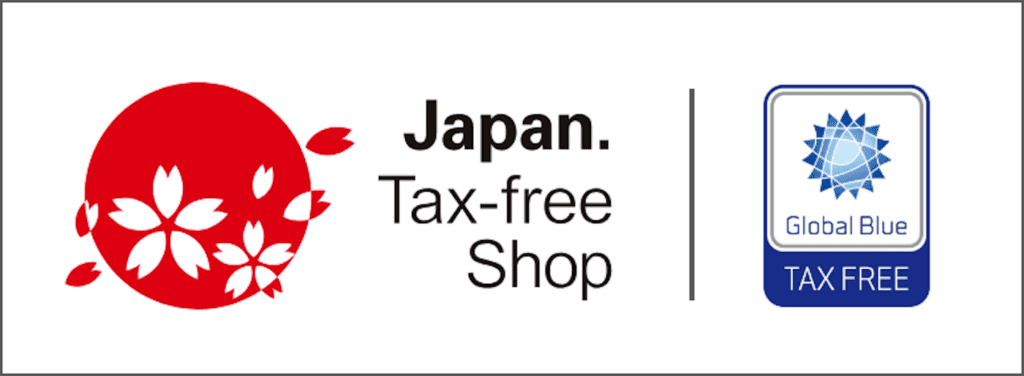
Tourist staying in Japan for under 6 months is entitled to a 10 % VAT refund on all purchases, except drinks and groceries. The purchases that are eligible for a VAT refund are general purchases for personal use such as electronics and clothing, and consumable goods like cosmetics and food. Consumable goods cannot be opened or used until you have left the country.
Keep a lookout for stores with the “tax-free shopping” sign, you can get the 10% off on the spot at dedicated counters instead of at the airport. You just need to carry your passport with you.
Have I missed anything? Let me know in the comments below if you have any cost-saving tips for Japan !
Related Posts
2 Days In Osaka Itinerary
1 Day Tokyo Itinerary
Ultimate 3 Days In Tokyo For First-Timers
The Perfect 1 Day Kyoto Itinerary
Minoh Falls – Osaka Day Trip
Guide To Hiking Fushimi Inari-Taisha
Where To Stay In Tokyo | 8 Best Neighbourhoods
19 Best Things To Do In Naha (and 1 to Skip): Complete Guide
Leaving Japan? Check out these posts on nearby destinations
4 Day Taipei Itinerary
Where To Stay In Taipei
10 Day Seoul Itinerary
28 Best Things To Do In Haeundae Beach
Guide To Yongkang Street – Asia’s Coolest Street
9 Best Areas To Stay In Bangkok
1 Day In Bangkok For First-Timers